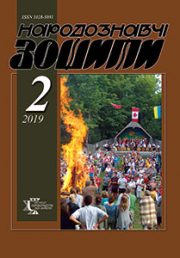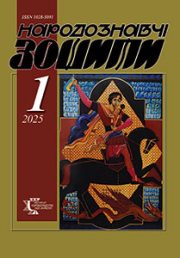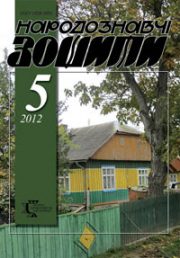The Ethnology Notebooks. 2024. № 5 (179), 1249—1257
UDK 7.031.4: 75.052: 7.077(477)”19″Гоменюк
DOI https://doi.org/10.15407/nz2024.05.1249
SHVIDIUK-BOHDAN Anastasiia
- ORCID ID: https://orcid.org/0009-0003-8242-6725
- PhD student at the Department of Art Theory and History,
- National Academy of Fine Arts and Architecture,
- 20, Voznesensky uzviz, 04053, Kyiv, Ukraine,
- Contacts: e-mail: Anastasiia.Shvydiuk@naoma.edu.ua
Abstract. This article explores the work of two naive artists from the Uman region, Yaryna and Sofia Homeniuk, through the prism of traditional house paintings of the Uman region. The paintings that existed on most of the territory of Ukraine in the late nineteenth and mid-twentieth centuries fell out of use, and today we have an idea of their appearance only thanks to the works of a number of scholars who conducted their field studies. To a certain extent, the tradition continued its life in the easel works of the Homeniuk sisters, and therefore, the purpose of our study is to highlight the relationship between the innovative approach in their work and the traditional environment from which it emerged. The objects of the study are the specifics of house paintings of Uman and Podillia and easel works by Y. and S. Homeniuk, their main plots, compositional schemes, and means of expression. The subject is the modifications that occurred to the tradition in the paintings of naive artists of the second half of the twentieth century. The study uses the methods of empirical (description based on sources and scientific literature) and theoretical research, including comparative analysis.
Results. After analyzing the works of Y. and S. Homeniuk, made with gouache on thick paper or cardboard, we came to the conclusion that, similar to the house paintings, their favorite motifs are floral, or rather, floral. On the canvases, one can sometimes recognize the usual «vases» and «friezes» of the folk master, which, however, become much more complicated, more diverse in terms of plasticity, and more refined in terms of painting and color. They have a plot and narrative, and plants sometimes turn into fantastic characters from fairy tales. The folklore that was inherent in folk painting is secondary here, plot-driven, subordinated to the author’s individual vision and a specific artistic image.
Keywords: folk art, decorative and applied art, house paintings, wall paintings, murals, naive art, Yaryna and Sofia Homeniuk.
Received 11.09.2024
REFERENCES
- Sherotskyi, K. (1914). Essays on the history of decorative art of Ukraine. Kyiv: Typ. «S.V. Kulzhenko» [in Russian].
- Krzeminsky, K. (1926). Wall paintings of Uman region: motifs of ornament. Kamianets-Podilskyi: Kamianets-Podilskyi Art and Industrial Vocational School [in Ukrainian].
- Levytska, L. (1928). Peasant painting in Podillia. Kyiv [in Ukrainian].
- Zarembskyi, A. (1928). Folk art of Podillia Ukrainians. Leningrad: Publication of the State Russian Museum [in Russian].
- Berchenko, E. (1930). Wall paintings of Ukrainian houses and outbuildings at them. Dnipropetrovs’k region (Notebook 1). Kharkiv; Kyiv: State Publishing House of Ukraine [in Ukrainian].
- Butnyk-Siverskyi, B. (1966). Ukrainian Soviet folk art. Kyiv: Naukova dumka [in Ukrainian].
- Naiden, O. (1989). Ornament of Ukrainian folk painting. Kyiv: Naukova dumka [in Ukrainian].
- Kosmina, T. (1980). Rural housing of Podillia in the late nineteenth and twentieth centuries. Kyiv: Naukova dumka [in Ukrainian].
- Studenets, N. (2010). Traditional mural painting of Podillia in the late nineteenth and early twentieth centuries. Kyiv: Rylsky Institute of Art History, Folklore and Ethnology [in Ukrainian].
- Kocherezhko, N. (1978). Solar colors. Kyiv: Veselka [in Ukrainian].
- Selivachov, M. (2013). Lexicon of Ukrainian ornamentation. 3rd edition. Kyiv: Ant; Phoenix [in Ukrainian].






